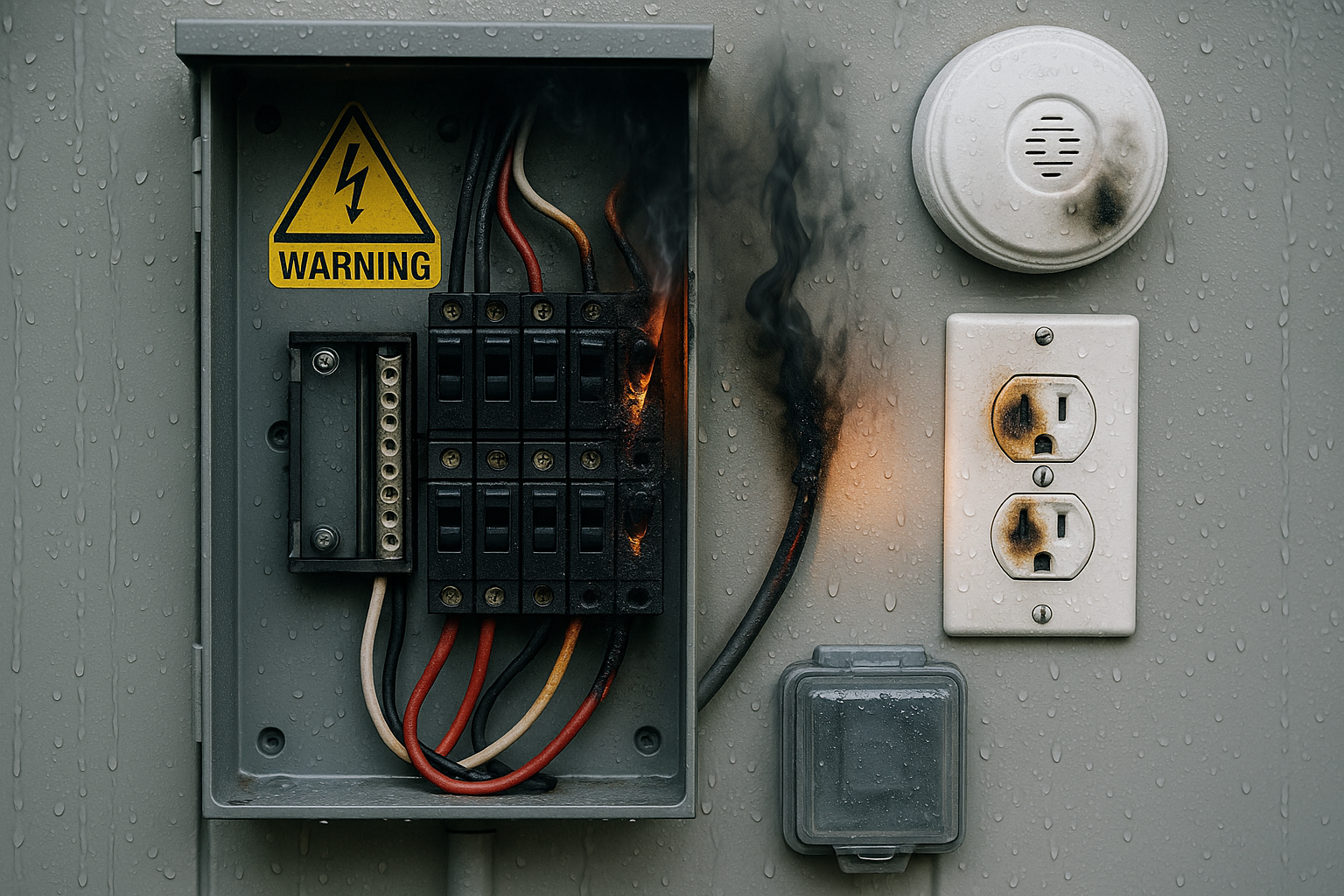Your home’s electrical system stands silent but essential. Water or fire damage might not show immediate visible results, yet hidden threats can risk both safety and comfort. This guide helps homeowners understand why electrical system protection matters. You’ll learn not just what happens during disasters, but also what to do next and how to secure your wiring, outlets, and panels for the future.
Risks to Electrical Systems from Water and Fire
Electrical systems are designed with precise tolerances. When either water or fire disrupts those boundaries, rapid deterioration can follow. Water, known as an efficient conductor, finds its way into every nook of the system. Even the smallest leak can create invisible bridges, sending current where it should never flow. This makes direct contact a severe safety risk. Electrocution becomes a possibility even with modest water exposure. According to information shared by ServPro Portland, standing water and hidden moisture in walls or floors can turn outlets and wiring into hidden hazards.
Short circuits often occur when water invades. As water seeps into junction boxes, panels, or receptacles, it completes circuits that were never supposed to close. Sparking may result, leading to a higher chance of electrical fires. This problem does not end when water dries. Floodwaters often carry corrosive substances , chemicals, minerals, sewage , all of which eat away at connections and components over time. A connection that looks safe now may fail months later, sometimes without warning. The Electrical Safety Foundation International highlights the long-term consequences of corrosion, which can go unnoticed until a system fails, putting both people and property in danger.
Fire creates different threats for the electrical system. High temperatures cause wire insulation to melt or shrink, leaving bare copper or aluminum exposed. These exposed wires touch metal, wood, or each other, sparking new fire hazards or increasing the risk of dangerous shocks. Fire often weakens framing or walls, causing pipes or wires to sag. Now, damaged structure and exposed wiring add fresh risk, sometimes in places no one would think to look. It only takes one faulty connection to create disastrous results later.
Warning Signs of Electrical Damage
Electrical issues rarely give clear warning before something breaks or a hazard appears. Still, a handful of common signs can tip you off. If you experience flickering lights, that’s often the first indication that wiring or receptacles have suffered. Variations in brightness point to inconsistent currents, which may reflect hidden breaks or water intrusion. This simple symptom should never be ignored, even if it seems to resolve. The cause may stop, but damage often remains.
A mysterious burning smell near an outlet or breaker panel demands immediate attention. This odor points to overheating components. Wires, outlets, or switches damaged by prior water or fire may be struggling to carry their expected load. The burning often comes from degraded insulation or melted plastics, both of which spell deep trouble for your electrical safety.
Discolored outlets, ranging from yellowish to brown or black stains, signal that heat is passing through places it should not. Charring or melting may also be visible. Even without an obvious burnt look, warping or softness at outlet covers or switch plates tells you material inside the wall has changed due to excess heat or moisture. Repeated tripping of circuit breakers after storms, leaks, or a recent fire suggests an unresolved fault somewhere in the wiring or a problem with a damaged breaker itself. Each trip is the panel defending you from overloads. If this keeps happening, the threat grows.
Immediate Response to Water or Fire Damage
Safety stands above all else after any disaster. Power and water do not mix. Even a minor incident, like an overflowing tub, can push water into contact with wires behind your walls. Bigger disasters, such as flash flooding or fire, will leave destruction in their wake. Wait for first responders or professionals to check your home before going inside. Safety professionals need to clear your property first.
If you safely enter the property, head to your main breaker panel. Only turn off power if you can do so safely. Stay away if you suspect water might have entered the breaker box, as even approaching could lead to shock. Alternatively, many homeowners call their utility provider for instructions. Most utility workers can shut off exterior power without entering your home. Keeping yourself and your family clear until safe remains a top priority.
Never step in standing water until professionals declare it safe. Any standing water in a basement or first floor with active electrical systems puts anyone at risk. Water may look clean but still hide live current. Treat every room with visible damage as unsafe until you’ve received all-clear guidance from your electrician or restoration expert.
Before cleanup begins, document the condition of your electrical system and the rest of your property. Take photos of panels, outlets, and areas that may be affected. These records help prove the extent of damage to insurance companies. Avoid removing panels or covers for these photos. Just show visible flooding, staining, or scorch markers for your claims adjuster. After images are captured, contact your restoration team, as cleanup should not begin until professional assessment confirms areas are de-energized and safe.
Contact Professionals for Electrical Help
Some jobs call for a licensed expert from the start. If you see exposed wires, damaged outlets, or anything that looks blackened or melted after fire or water exposure, call an electrician. Never try to patch up or reconnect these parts on your own , the risk of shock, fire, or further damage is too high.
Significant water exposure means professional attention is needed. Even if the breaker panel came through unharmed, water entering outlets, basement boxes, or crawlspaces puts the entire circuit at risk. Only a qualified electrician can test for hidden moisture and corrosion. The ESFI recommends tossing out any electrical equipment , even if it appears clean , after a major flood or leak, to avoid hidden weaknesses that show up months later.
Persistent problems, such as lights dimming, outlets losing power intermittently, or circuit breakers refusing to reset, point to deep wiring issues. These may not seem urgent at first but each repetition increases risk of shock and electrical fire. Professional intervention ensures every compromised circuit or device is either safely repaired or replaced before causing more damage.
Practical Tips for Prevention
With a few key steps, most homeowners can prevent disasters before they start. Ground Fault Circuit Interrupters, often called GFCI outlets, sense the smallest leak of current. When water enters the picture, they instantly cut off power, stopping shock and reducing fire hazard. Install GFCIs in kitchens, bathrooms, laundry areas, and all exterior outlets. These simple upgrades can save lives in rooms where water and electricity often meet. Guidance from sources like Parkin Electric suggests GFCIs play a big role in home safety.
In areas prone to flooding, consider positioning wall outlets, switches, and junction boxes higher up the wall. Raising these above previous flood lines or common water entry points protects your wiring and receptacles from inundation. In basements, garages, or lower-level rooms, move fuse boxes and circuit breakers as high as local codes allow. This single step protects both people and infrastructure during even unexpected deluges. HGTV’s experts recommend elevating critical wiring to control future risk, reducing both the scope and cost of repairs later.
Whole-house surge protectors attach at the main breaker panel. When a storm sends extra voltage through the grid, these units absorb excess power before it reaches your outlets or appliances. Surges come during storms, accidents, or restoration after service loss. A surge protector defends computers, fridges, and even your HVAC from being fried. Modern systems cut current to prevent sparking and heat. More on this can be found at Mister Sparky.
Annual inspections by a qualified, licensed electrician spot problems before you do. These professionals check connections, look for discoloration, and test GFCIs and surge protectors. Damaged wiring, cracked insulation, and corroded terminals often show up years before a short or breaker trip. Contractors can also give advice about upgrades as electrical codes change.
Maintenance matters outside the home, too. A roof in good repair, clear gutters, and proper grading all reduce water reaching your electrical system in the first place. Falling leaves, moss, or even missing shingles channel water along hidden paths, letting it seep behind siding or walls. Regularly clean gutters and downspouts so that water moves away from foundations and outside electrical panels. Exact Recon explains that sound exterior maintenance forms your first protective line around the entire electrical system.
Long-Term Electrical System Protection
Keep a log of inspections, repairs, and upgrades. Whenever a contractor works on your system, note it. Update your home insurance as you add surge protection or elevate wiring. Some insurers offer discounts for these upgrades. If you live in an older home, talk to your electrician about rewiring or modernizing dangerous cloth-insulated or knob-and-tube systems. New materials resist fire and moisture better, adding an extra layer of safety. After every major storm or disaster, walk through your home, checking outlets, panels, and visible wiring for changes.
Develop a simple emergency plan with your family. Assign someone to call for help, someone to take photos, and someone else to keep the power shut off until clearance is given. Post utility emergency numbers near your main electrical panel and in your mobile phone. Teach children, guests, and tenants never to reset a breaker or touch wet outlets.
Consult with professional restoration companies or electrical contractors, such as Austin Hi-Tech Restoration, to assess your home’s unique risks. They can recommend custom upgrades or inspection routines for your area’s threats, whether wildfires, hurricanes, or flash flooding.
Making Electrical Protection Part of Everyday Life
Electrical system protection should become an ongoing part of home safety. Watch for small warnings, schedule annual checkups, and act immediately when faced with leaks or smoke. Upgrades like GFCI outlets, surge protection, and raising wiring in flood regions will pay back if disaster ever strikes. A prepared homeowner is a safe homeowner. Keeping your wiring dry and undamaged shields both your family and your investment for years to come.


